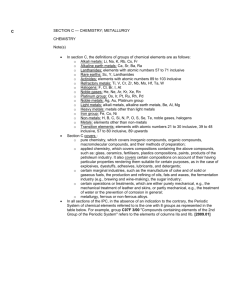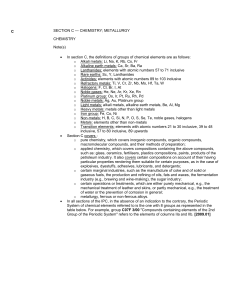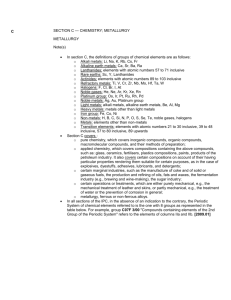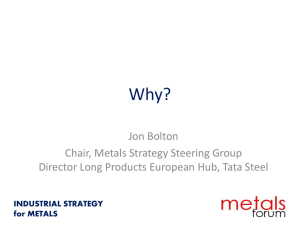C09F
advertisement
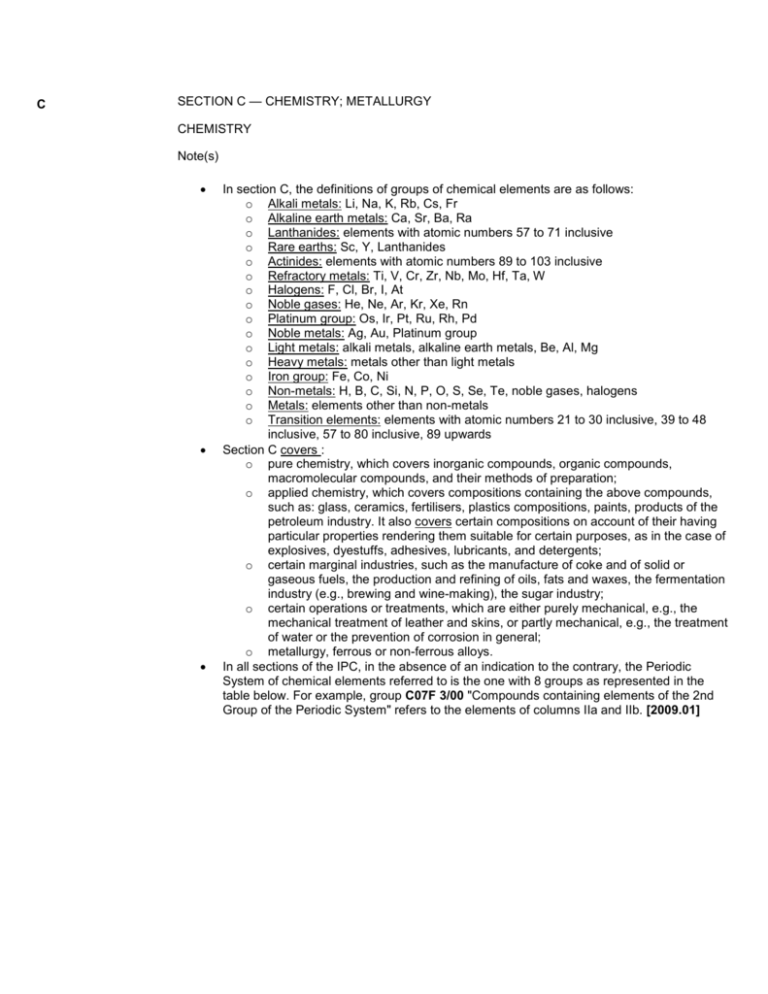
C SECTION C — CHEMISTRY; METALLURGY CHEMISTRY Note(s) In section C, the definitions of groups of chemical elements are as follows: o Alkali metals: Li, Na, K, Rb, Cs, Fr o Alkaline earth metals: Ca, Sr, Ba, Ra o Lanthanides: elements with atomic numbers 57 to 71 inclusive o Rare earths: Sc, Y, Lanthanides o Actinides: elements with atomic numbers 89 to 103 inclusive o Refractory metals: Ti, V, Cr, Zr, Nb, Mo, Hf, Ta, W o Halogens: F, Cl, Br, I, At o Noble gases: He, Ne, Ar, Kr, Xe, Rn o Platinum group: Os, Ir, Pt, Ru, Rh, Pd o Noble metals: Ag, Au, Platinum group o Light metals: alkali metals, alkaline earth metals, Be, Al, Mg o Heavy metals: metals other than light metals o Iron group: Fe, Co, Ni o Non-metals: H, B, C, Si, N, P, O, S, Se, Te, noble gases, halogens o Metals: elements other than non-metals o Transition elements: elements with atomic numbers 21 to 30 inclusive, 39 to 48 inclusive, 57 to 80 inclusive, 89 upwards Section C covers : o pure chemistry, which covers inorganic compounds, organic compounds, macromolecular compounds, and their methods of preparation; o applied chemistry, which covers compositions containing the above compounds, such as: glass, ceramics, fertilisers, plastics compositions, paints, products of the petroleum industry. It also covers certain compositions on account of their having particular properties rendering them suitable for certain purposes, as in the case of explosives, dyestuffs, adhesives, lubricants, and detergents; o certain marginal industries, such as the manufacture of coke and of solid or gaseous fuels, the production and refining of oils, fats and waxes, the fermentation industry (e.g., brewing and wine-making), the sugar industry; o certain operations or treatments, which are either purely mechanical, e.g., the mechanical treatment of leather and skins, or partly mechanical, e.g., the treatment of water or the prevention of corrosion in general; o metallurgy, ferrous or non-ferrous alloys. In all sections of the IPC, in the absence of an indication to the contrary, the Periodic System of chemical elements referred to is the one with 8 groups as represented in the table below. For example, group C07F 3/00 "Compounds containing elements of the 2nd Group of the Periodic System" refers to the elements of columns IIa and IIb. [2009.01] o o o o In the case of operations, treatments, products or articles having both a chemical and a non-chemical part or aspect, the general rule is that the chemical part or aspect is covered by section C. In some of these cases, the chemical part or aspect brings with it a non-chemical one, even though purely mechanical, because this latter aspect either is essential to the operation or treatment or constitutes an important element thereof. It has seemed, in fact, more logical not to dissociate the different parts or aspects of a coherent whole. This is the case for applied chemistry and for the industries, operations and treatments mentioned in Notes (1)(c), (d) and (e). For example, furnaces peculiar to the manufacture of glass are covered by class C03 and not by class F27. There are, however, some exceptions in which the mechanical (or non-chemical) aspect carries with it the chemical aspect, for example: Certain extractive processes, in subclass A61K; The chemical purification of air, in subclass A61L; Chemical methods of fire-fighting, in subclass A62D; Chemical processes and apparatus, in class B01; Impregnation of wood, in subclass B27K; Chemical methods of analysis or testing, in subclass G01N; Photographic materials and processes, in class G03, and, generally, the chemical treatment of textiles and the production of cellulose or paper, in section D. o o In still other cases, the pure chemical aspect is covered by section C and the applied chemical aspect by another section, such as A, B or F, e.g., the use of a substance or composition for: treatment of plants or animals, covered by subclass A01N; foodstuffs, covered by class A23; ammunition or explosives, covered by class F42. When the chemical and mechanical aspects are so closely interlocked that a neat and simple division is not possible, or when certain mechanical processes follow as a natural or logical continuation of a chemical treatment, section C may cover, in addition to the chemical aspect, a part only of the mechanical aspect, e.g., aftertreatment of artificial stone, covered by class C04. In this latter case, a note or a reference is usually given to make the position clear, even if sometimes the division is rather arbitrary. C09 DYES; PAINTS; POLISHES; NATURAL RESINS; ADHESIVES; COMPOSITIONS NOT OTHERWISE PROVIDED FOR; APPLICATIONS OF MATERIALS NOT OTHERWISE PROVIDED FOR C09F NATURAL RESINS; FRENCH POLISH; DRYING-OILS; DRIERS (SICCATIVES); TURPENTINE C09F 1/00 Obtaining, purification, or chemical modification of natural resins, e.g. oleo-resins C09F 1/02 · Purification C09F 1/04 · Chemical modification, e.g. esterification C09F 3/00 Obtaining spirits of turpentine C09F 3/02 · as a by-product in the paper-pulping process C09F 5/00 Obtaining drying-oils C09F 5/02 · from natural sources C09F 5/04 · · from cashew nuts C09F 5/06 · by dehydration of hydroxylated fatty acids or oils C09F 5/08 · by esterification of fatty acids C09F 5/10 · Refining C09F 5/12 · · by distillation C09F 7/00 Chemical modification of drying-oils (factice C08H ) C09F 7/02 · by oxidising C09F 7/04 · by voltolising C09F 7/06 · by polymerisation C09F 7/08 · by isomerisation C09F 7/10 · by re-esterification C09F 7/12 · Apparatus therefor C09F 9/00 Compounds to be used as driers (siccatives) C09F 11/00 Preparation of French polish
